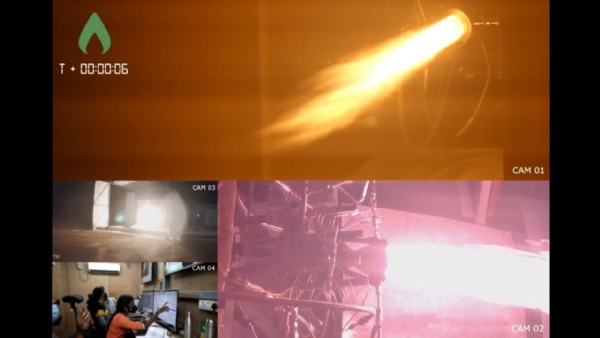Huge leap in space privatisation sector! Agnikul test-fires 3-D printed semi-cryo rocket engine
Total Views |
Chennai, February 10: Giving a major push to Make In India, India's Space start-up Agnikul Cosmos, successfully test-fire their semi cryogenic rocket engine that has fully manufactured using 3-D printing technology. With that company has carved its niche in space and becomes the first company to fire a single-piece fully 3D printed rocket engine.

AgniKul Cosmos Private Limited is an Indian aerospace manufacturer based in the National Center for Combustion R&D (NCRD) of IIT Madras, Chennai. The start-up aims to develop and launch its small-lift launch vehicle namely Agnibaan, capable of placing 100 kg (220 lb) payload into a 700 km (430 mi) orbit. The first commercial launch is expected in 2022.
According to the space start-up company, the semi-cryogenic engine, called Agnilet, would be fulled of rocket-grade kerosene and uses liquid oxygen (stored at -183 degrees celsius) as an oxidizer.
It should be noted that rocket engines are tough to build and they are even tougher to 3D print, however, taking that risk successfully fired the Agnilet. It is a three-in-one solution. It takes all three of these modules and puts them into a single piece of hardware. There is no complex assembly and the turnaround time for the entire setup is less than four days.
Talking about the engine companies co-founder and CEO Srinath Ravichandran said, “This entire engine, Agnilet, is just one piece of hardware from start to finish and has zero assembled parts.”
The rocket engine is capable of carrying up to 100 kilos to low earth orbit (LEO), which is around 700 kilometers above the Earth’s surface.
Noting their success Mahindra Group Chairman Anand Mahindra has invested in his capacity in Angikul Cosmos Pvt. Ltd.
In December, Agnikul became the first space startup to sign a pact with the Indian Space Research Organisation (ISRO) to tap into the space agency's expertise as well as its facilities to build its rocket, since the country opened up the space sector for the private industry.